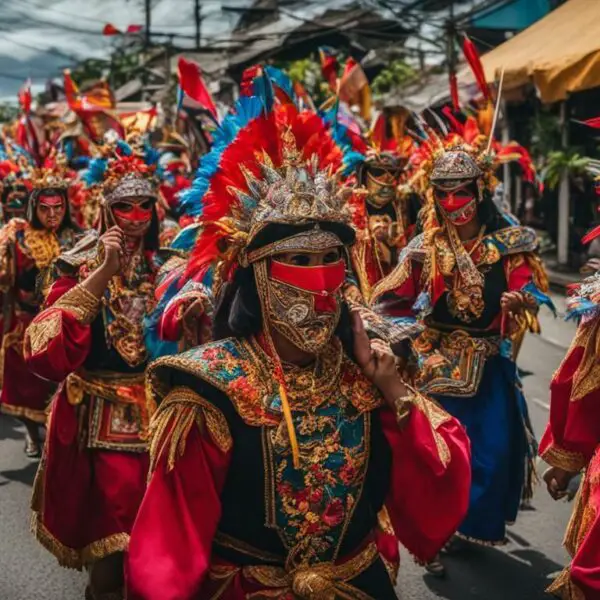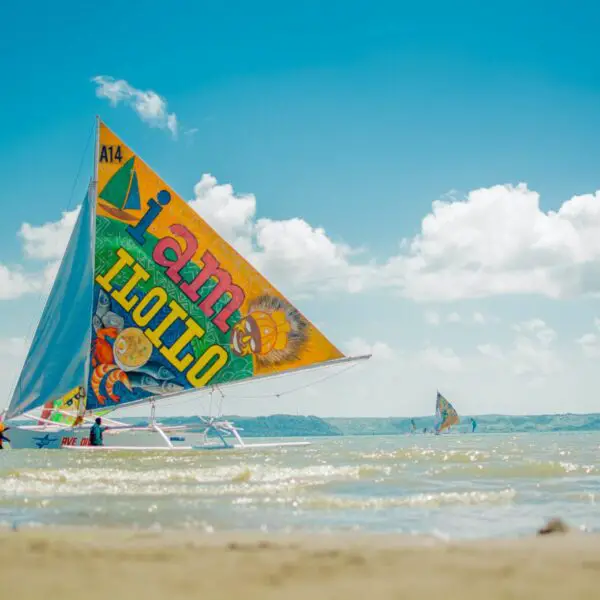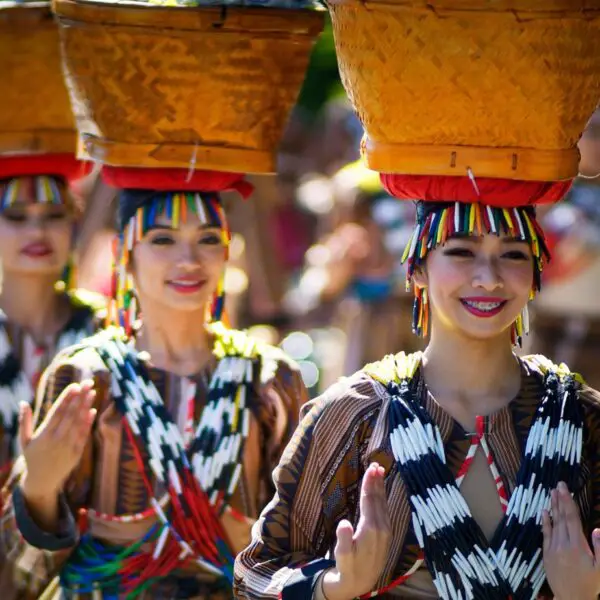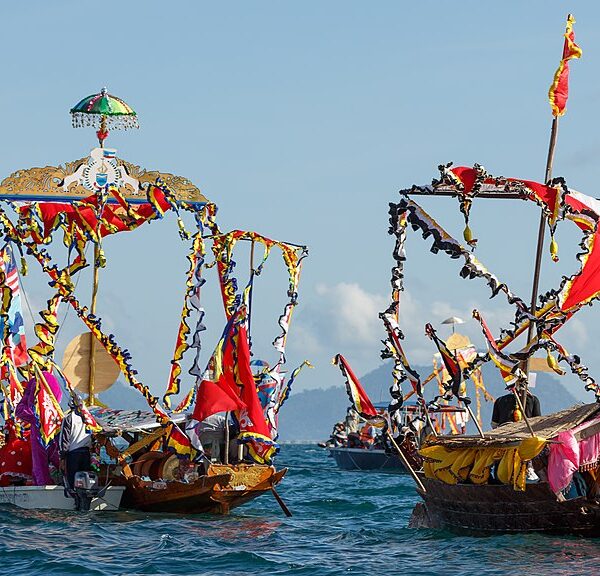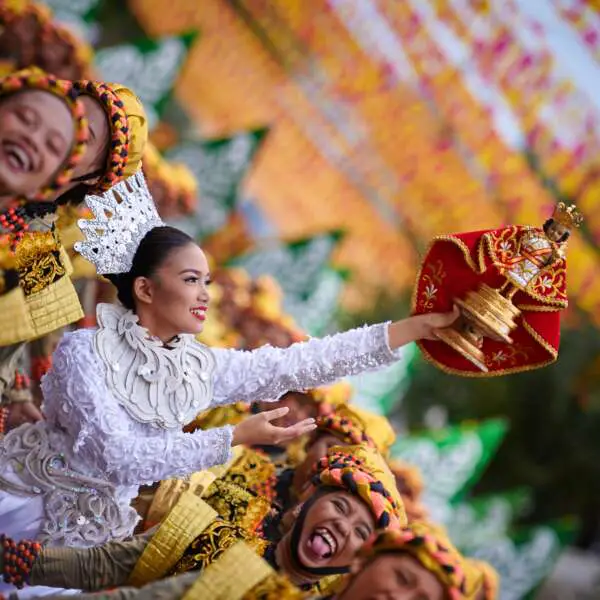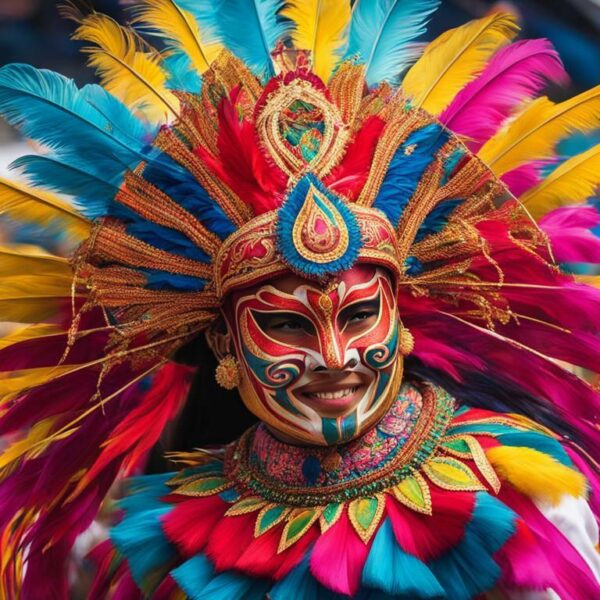Flores de Mayo is a vibrant and colorful fiesta celebrated in the Philippines during the month of May, showcasing the rich cultural heritage of the Filipino people. This lively festival is a celebration of May devotions to the Blessed Virgin Mary and holds both religious and cultural significance. Participants engage in various devotional practices such as reciting the rosary, offering prayers and flowers to the Virgin Mary, and participating in processions.
One of the highlights of Flores de Mayo is the Santacruzan, a ritual pageant that commemorates the finding of the True Cross by Saint Helena and Constantine the Great. This grand parade features representations of biblical and historical figures, as well as depictions of Marian apparitions and dogmas. It is a spectacular display of faith and tradition, captivating both locals and visitors alike.
Throughout the Philippines, different regions have their own customs and traditions associated with Flores de Mayo. These regional variations add a unique flavor to the festival, ensuring that each celebration is distinct and special. From costumes and rituals to local delicacies and music, the local customs contribute to the overall vibrancy and excitement of the fiesta.
Participating in the festivities of Flores de Mayo allows visitors to immerse themselves in the cultural heritage of the Filipino people. The festive atmosphere, the vivid colors, and the sense of community make this celebration a truly immersive experience. May is the perfect time to witness the beauty of Flores de Mayo and explore the traditions and customs that have been passed down through generations.
Key Takeaways:
- Flores de Mayo is a vibrant and colorful fiesta celebrated in the Philippines during the month of May.
- The festival showcases the rich cultural heritage of the Filipino people.
- It is a celebration of May devotions to the Blessed Virgin Mary.
- The Santacruzan, a ritual pageant, is a highlight of Flores de Mayo.
- Participants engage in devotional practices and processions during the festival.
The Significance of Flores de Mayo
Flores de Mayo holds great religious and cultural significance as it pays homage to the May devotions and celebrates the virtuous figure of the Blessed Virgin Mary. This vibrant festival, observed annually in the Philippines during the month of May, brings together the Filipino Catholic community in a joyous celebration of faith and heritage.
The devotion to the Blessed Virgin Mary during May is deeply rooted in the Filipino culture. It is a time for the faithful to express their love and devotion through prayer, offering of flowers, and participation in processions. Flores de Mayo serves as a reminder of the spiritual teachings and values exemplified by the Virgin Mary, and the festival allows the community to come together and honor her through various rituals and traditions.
One of the highlights of Flores de Mayo is the Santacruzan, a grand ritual pageant that commemorates the finding of the True Cross by Saint Helena and Constantine the Great. This colorful parade features beautifully dressed participants, representing biblical and historical figures, as well as depictions of Marian apparitions and dogmas. The Santacruzan is a visual spectacle that showcases the rich history and religious heritage of the Filipino people.
| Key Significance | May Devotions | Blessed Virgin Mary | Religious and Cultural Significance |
|---|---|---|---|
| Pay homage | Express love and devotion | Symbol of virtuousness | Celebration of faith and heritage |
| Deeply rooted | Philippine culture | Spiritual teachings | Unity of the community |
| Commemoration | Santacruzan | True Cross by Saint Helena and Constantine the Great | Visual spectacle of history and religious heritage |
Throughout the country, different regions have their own customs and traditions associated with Flores de Mayo. These regional variations add diversity and uniqueness to the festival, reflecting the rich cultural tapestry of the Filipino people. From special dishes to ceremonial practices, each region showcases its distinct heritage during this colorful fiesta.
Flores de Mayo is not only a celebration of devotion, but also a preservation of Filipino cultural heritage. Through this festival, the Filipino people proudly showcase their customs, traditions, and religious faith to the world. Merging religious rituals with vibrant festivities, Flores de Mayo beautifully captures the essence of Filipino identity and serves as a reminder of the country’s deep-rooted connection to the Blessed Virgin Mary and the values she represents.
The Santacruzan: A Ritual Pageant
One of the highlights of the Flores de Mayo festival is the Santacruzan, a ritual pageant that commemorates the finding of the True Cross by Saint Helena and Constantine the Great. This grand procession showcases the religious and historical significance of the festival, captivating both locals and tourists alike.
During the Santacruzan, participants dress in elaborate costumes, embodying biblical and historical figures. They walk through the streets, accompanied by colorful floats adorned with flowers and religious symbols. This stunning display of devotion and heritage reflects the strong cultural ties of the Filipino people to their Catholic faith.
As the procession moves forward, it is not uncommon to witness depictions of famous Marian apparitions and dogmas. These representations further enhance the spiritual and symbolic nature of the Santacruzan, creating a truly captivating experience for all who witness it.
| Symbol | Meaning |
|---|---|
| Rose | Symbolizes the Virgin Mary |
| Star | Represents the guiding light to Christ |
| Dove | Symbolizes the Holy Spirit |
| Angels | Depict celestial beings |
The Santacruzan is not only a beautiful spectacle, but it also serves as a reminder of the rich history and traditions that the Filipino people hold dear. It is a celebration of faith, devotion, and the cultural heritage that has been passed down through generations.
Quote:
“The Santacruzan is a testament to the deep-rooted spirituality of the Filipino people and their enduring devotion to the Blessed Virgin Mary.” – Local historian
For those fortunate enough to experience the Flores de Mayo festival, witnessing the Santacruzan is an unforgettable and awe-inspiring experience. It allows visitors to immerse themselves in the vibrant festivities and gain a deeper understanding of the religious and cultural traditions that make the Philippines unique.
Devotions and Processions
Throughout Flores de Mayo, participants engage in various devotions, including the recitation of the rosary, the offering of prayers and flowers to the Virgin Mary, and the joyful participation in processions. These devotional practices are deeply rooted in the Filipino Catholic tradition and reflect the strong devotion of the people to Mary, the Blessed Mother.
The recitation of the rosary holds a special significance during Flores de Mayo. Families and communities come together to pray the rosary, reflecting on the mysteries of the life of Jesus and Mary. The rosary beads, held in their hands, provide a tangible connection to their faith and a means for offering their prayers to the Virgin Mary.
In addition to prayer, the offering of flowers is a common practice during the festival. Participants bring bouquets of vibrant blooms, symbolizing their love and devotion to Mary. These floral offerings are presented at altars dedicated to the Virgin Mary, creating a colorful and fragrant tribute to her grace and beauty.
Processions: A Joyous Celebration of Faith
Another integral part of Flores de Mayo is the participation in processions. These processions, filled with music and joyful celebration, take place in towns and villages across the Philippines. Participants, dressed in their finest attire, carry religious images and statues of the Virgin Mary as they parade through the streets.
The processions are a visual spectacle, with colorful banners, intricate decorations, and the sound of hymns filling the air. It is a time for the community to come together, expressing their devotion and honoring the Blessed Mother.
| Engage in Devotions | Offer Prayers and Flowers | Participate in Processions |
|---|---|---|
| Recite the rosary | Present bouquets of flowers | Carry religious images |
| Reflect on the mysteries of the life of Jesus and Mary | Symbolize love and devotion to Mary | Parade through the streets |
| Create a tangible connection to their faith | Pay tribute to her grace and beauty | Express devotion and honor the Blessed Mother |
“Flores de Mayo is a time of deep spiritual connection and festive rejoicing. It is a celebration of faith, love, and cultural heritage, where the Filipino people come together to honor the Virgin Mary and showcase their vibrant traditions.”
The Spectacular Santacruzan Parade
The Santacruzan parade during Flores de Mayo is a spectacle of grandeur, featuring captivating representations of biblical and historical figures, as well as vibrant depictions of Marian apparitions and dogmas. This elaborate procession showcases the rich religious and cultural heritage of the Filipino people, drawing participants and spectators from all walks of life.
As the parade winds its way through the streets, viewers are treated to a visual feast of colorful costumes and intricate floats. Biblical characters such as King Solomon, Queen Esther, and Mary Magdalene come to life, transporting onlookers to ancient times. Historical figures like Queen Isabella and Joan of Arc make appearances, representing the strong connection between faith and history.
The Santacruzan parade also pays homage to Marian apparitions and dogmas, with beautifully adorned floats depicting significant moments in Catholic history. From the apparition of Our Lady of Fatima to the solemn proclamation of the Assumption of Mary, these visual representations serve as powerful reminders of the devotion and faith of the Filipino people.
| Floats Representing Marian Apparitions and Dogmas |
|---|
| Our Lady of Guadalupe |
| Our Lady of Lourdes |
| Our Lady of Miraculous Medal |
| Our Lady of the Rosary |
| Assumption of Mary |
The Santacruzan parade is a testament to the strong faith and cultural pride of the Filipino people. It serves as a celebration of devotion and heritage, bringing communities together to honor their shared beliefs and traditions. This vibrant display of faith and culture is a truly unforgettable experience for locals and tourists alike, showcasing the beauty and diversity of the Philippines.
Regional Customs and Traditions
Flores de Mayo is celebrated throughout the Philippines, with each region adding its distinct customs and traditions to the festivities. The diversity and uniqueness of these regional practices contribute to the vibrant tapestry of the festival, making it an exciting and enriching experience for both locals and visitors.
In the northern region of Ilocos, the celebration is known as the “Sarakiki Festival.” It features street dances and parades depicting the rich history and cultural heritage of the region. Participants dress in colorful traditional costumes and showcase the local music and dance forms, creating a lively and captivating atmosphere.
Meanwhile, in the central region of Visayas, a popular tradition is the “Pahiyas Festival” held in Lucban, Quezon. This agricultural festival is a visual feast for the eyes, as the streets are adorned with colorful rice decor, fruits, vegetables, and kiping (rice wafers). The locals showcase their creativity by transforming their homes into stunning works of art.
| Region | Customs and Traditions |
|---|---|
| Ilocos | Sarakiki Festival – street dances and parades depicting the rich history and cultural heritage of the region |
| Visayas | Pahiyas Festival – agricultural festival with colorful rice decor, fruits, vegetables, and kiping |
In the southern region of Mindanao, the people celebrate the “Kadayawan Festival” in Davao City. It is a week-long festivity that showcases the indigenous culture and bountiful harvest of the region. The festival features floral floats, street dances, and a grand parade highlighting the cultural diversity of Mindanao.
These are just a few examples of the many customs and traditions associated with Flores de Mayo in different regions of the Philippines. From street dances and parades to agricultural displays and cultural showcases, each region offers a unique perspective on the festival, giving visitors a chance to immerse themselves in the rich cultural tapestry of the country.
A Celebration of Devotion and Heritage
Flores de Mayo is not just a celebration, but a testament to the unwavering devotion of the Filipino people to Mary, as well as a vibrant display of their rich cultural heritage. This annual festival, held in the month of May, is a colorful and joyous occasion that commemorates May devotions to the Blessed Virgin Mary.
During Flores de Mayo, participants engage in various devotional practices, such as reciting the rosary, offering prayers, and presenting flowers to the Virgin Mary. Processions form an integral part of the festival, where communities come together to honor Mary and seek her blessings. These processions are a sight to behold, with devotees dressed in traditional attire and carrying religious icons.
The highlight of Flores de Mayo is the Santacruzan, a grand parade that symbolizes the search for the True Cross by Saint Helena and Constantine the Great. The procession features majestic floats adorned with biblical and historical figures, as well as depictions of Marian apparitions and dogmas. The Santacruzan showcases the artistic talents of the Filipino people, as well as their deep faith and reverence for Mary.
One of the most fascinating aspects of Flores de Mayo is the regional customs and traditions associated with the festival. Different parts of the Philippines have their own unique ways of celebrating, adding to the diversity and richness of the festivities. From the elaborate floral arrangements in the Visayas region to the ceremonial rituals in Luzon, each region brings its own flavor and flair to the celebration.
| Key Points | Details |
|---|---|
| Devotions | Recitation of the rosary, offering of prayers and flowers to the Virgin Mary |
| Processions | Grand parades where communities honor Mary and seek her blessings |
| Santacruzan | Ritual pageant featuring biblical and historical figures, as well as representations of Marian apparitions and dogmas |
| Regional Customs and Traditions | Each region in the Philippines has its own unique ways of celebrating Flores de Mayo |
Flores de Mayo is a time for the Filipino people to come together, celebrate their faith, and showcase their cultural heritage. It is a festival that not only honors Mary but also preserves and promotes the traditions and customs that are deeply rooted in Filipino society. With its vibrant colors, devotional practices, and regional variations, Flores de Mayo truly encapsulates the spirit of devotion and the rich cultural heritage of the Philippines.
Immersing in the Festivities
Don’t miss out on the opportunity to immerse yourself in the festive atmosphere of Flores de Mayo and relish the cultural heritage of the Philippines this May. The month of May is the perfect time to experience this vibrant fiesta, as it is when the Flores de Mayo festival takes place. This colorful celebration is a blend of religious devotion and cultural traditions, making it a unique and captivating experience for all participants.
During Flores de Mayo, the streets come alive with processions and parades, filled with joyful music, colorful costumes, and intricate decorations. The festive atmosphere is contagious, creating a sense of unity and excitement among the participants. Whether you are a local or a visitor, joining in the festivities allows you to fully immerse yourself in the rich cultural heritage of the Philippines.
The highlight of the festival is the Santacruzan parade, a grand spectacle featuring beautifully dressed participants representing biblical figures, historical characters, and various interpretations of Marian apparitions and dogmas. This elaborate display showcases the creativity and devotion of the Filipino people, as they pay homage to their religious beliefs and honor the Blessed Virgin Mary.
A Table of Key Events during Flores de Mayo
| Date | Event |
|---|---|
| May 1 | Start of the Flores de Mayo festival |
| Throughout May | Recitation of the rosary, offering of prayers and flowers to the Virgin Mary |
| Various dates | Regional processions and Santacruzan parades |
| Last Sunday of May | Final day of Flores de Mayo |
Participating in the Flores de Mayo festival allows you to fully appreciate the Filipino people’s devotion to Mary and their rich cultural heritage. It is a time to celebrate, honor, and preserve the customs and traditions that have been passed down through generations. So, why not join the festivities this May and witness the beauty and vibrancy of Flores de Mayo for yourself?
Conclusion
Flores de Mayo in May is a vibrant and festive celebration that honors the cultural heritage of the Filipino people, inviting everyone to join in the joyous festivities and discover the beauty of this cherished tradition.
The Flores de Mayo festival is not only a religious observance but also a testament to the unique customs and traditions that have been passed down through generations. It serves as a vivid portrayal of the Filipino people’s deep devotion to the Blessed Virgin Mary and their commitment to preserving their rich cultural heritage.
During this colorful fiesta, participants engage in various devotional practices such as reciting the rosary, offering prayers, and presenting flowers to the Virgin Mary. Processions take place, with individuals proudly parading through the streets, showcasing their reverence for the Blessed Virgin Mary.
The highlight of the Flores de Mayo festival is the Santacruzan, a grand parade that features biblical and historical figures, as well as depictions of Marian apparitions and dogmas. This spectacle not only adds to the festive atmosphere but also reminds participants of the significant historical events associated with the finding of the True Cross by Saint Helena and Constantine the Great.
Throughout the country, different regions have their own unique customs and traditions that make Flores de Mayo even more vibrant and diverse. From intricate costumes to elaborate rituals, each region adds its own flair to the celebration, creating a truly immersive experience for all participants.
In conclusion, Flores de Mayo in May is a celebration that embodies the essence of the Filipino spirit – a deep-rooted devotion to their religious beliefs and a strong sense of pride in their cultural heritage. It is a time to come together, embrace the festive atmosphere, and immerse oneself in the beauty of this cherished tradition.
FAQ
What is the Flores de Mayo festival?
The Flores de Mayo festival is a celebration of May devotions to the Blessed Virgin Mary that is held in the Philippines during the month of May.
What is the Santacruzan?
The Santacruzan is a ritual pageant that is part of the Flores de Mayo festival. It honors the finding of the True Cross by Saint Helena and Constantine the Great.
What activities take place during Flores de Mayo?
Participants in the festival recite the rosary, offer prayers and flowers to the Virgin Mary, and take part in processions.
What can I expect to see in the Santacruzan parade?
The Santacruzan parade features biblical and historical figures, as well as representations of Marian apparitions and dogmas.
Are there regional variations in Flores de Mayo customs?
Yes, different regions in the Philippines have their own customs and traditions associated with the festival.
What does Flores de Mayo signify?
Flores de Mayo signifies the strong devotion of the Filipino people to the Blessed Virgin Mary and showcases their rich cultural heritage.
When is the best time to experience the Flores de Mayo festival?
The festival takes place in the month of May, so that is the best time to immerse yourself in the festive atmosphere and participate in the activities.
